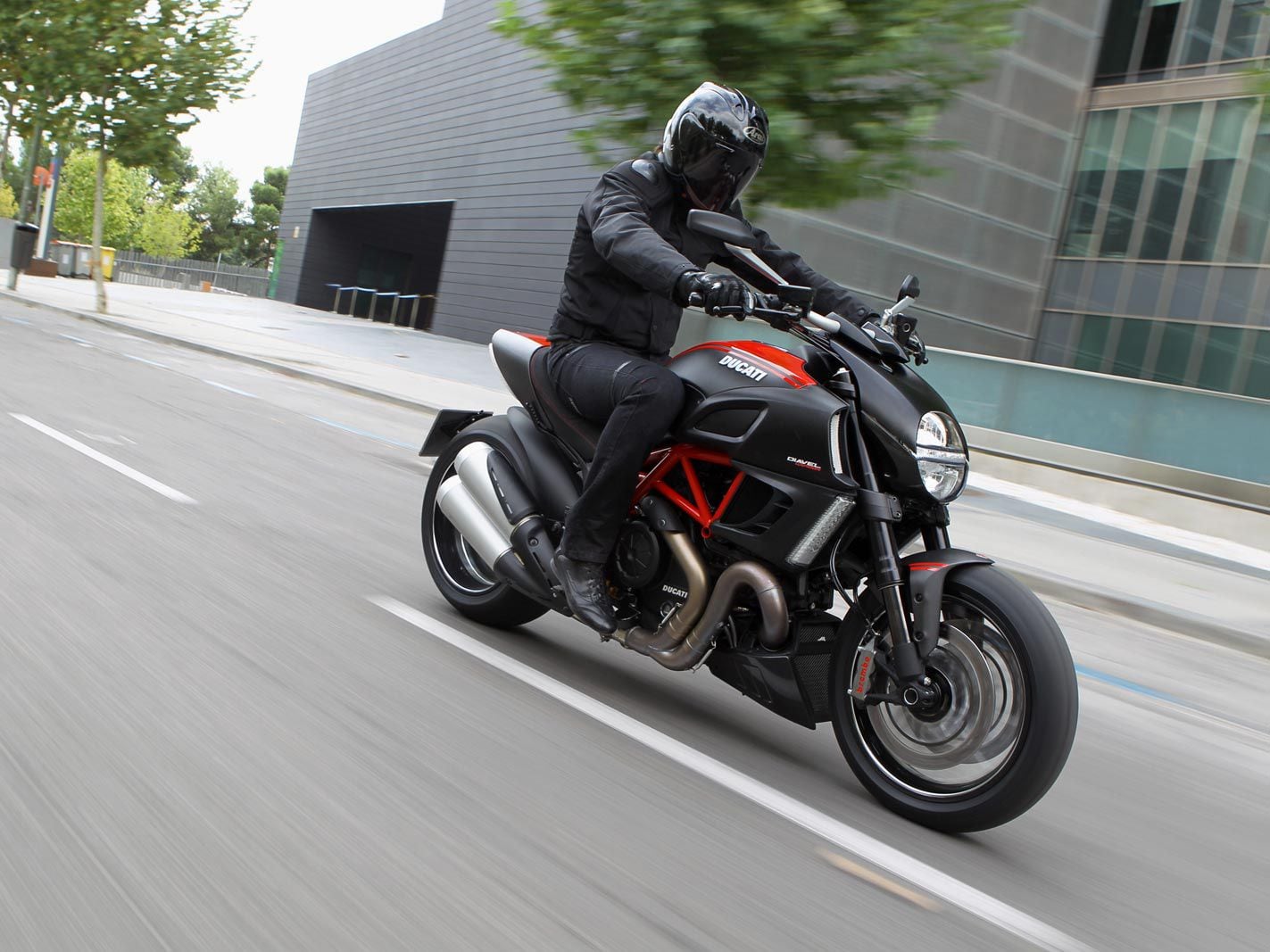We might see ourselves as sober, responsible riders who obey the speed limit and stop at intersections to help little old ladies cross the street, but beneath that mild-mannered exterior lurks a hoodlum in disguise, a scofflaw who just wants to find a deserted stretch of road, yell, “Punch it, Chewie!” and make the scenery blurry. There’s nothing better for unleashing your wild side than a big, brawny muscle bike, and if you’re hankering for a fix of old-fashioned speed, the used market is teeming with willing accomplices.
The first-generation Yamaha V-Max, made from 1985 through 2007, put muscle bikes on the map with its 1,197cc, 145-hp V-4 with V-Boost, which kicked in at 5,750 rpm and gave the 631-pound shaft-drive cruiser a punch in the powerband like a 125cc motocrosser coming on the pipe. Discussions about handling, however, often led V-Max owners to change the subject. (Hey, how about those Dodgers, huh?) Along with a different styling of its name, the Gen 2 VMAX (technically a “Star” by then) debuted in 2008 with a displacement bump to 1,679cc, an aluminum frame, adjustable suspension, ABS, and the same appetite for the pink slips of pretenders. If you haven’t experienced it, the feeling of a 1.7-liter VMAX at full song is truly a unique and incredible sensation. Gen 1 V-Max prices range from $3,250 to $6,225, while later ones will set you back anywhere from $11,675 on up. Pay attention to the clutch on all years and gearbox function—especially second gear—in early ones. Lastly, it might be time to consider the VMAX a collector, as rumor has it Yamaha might finally cancel the big V-4 yet again.
Unlike Yamaha’s long-lived Mad Max, Suzuki’s B-King was a one-year wonder (2008), but what a wonder it was, with a 160-hp Hayabusa-sourced four-cylinder engine with an aluminum frame and swingarm, an inverted fork, a single rear shock, and a relaxed seating position where you could catch your breath after a session of arm-straightening excursions to redline. The B-King’s ferocity at full chat belied its calm around-town manners, and for a bike whose métier is shredding rear tires and fragging drive chains, it’s a very civilized day-to-day ride. If you can stomach the styling and those ray-gun mufflers, the B-King is a brawny naked bike with proven reliability and eye-watering performance. Look to spend around $6,500 for a good one and a bit more for the ABS model, but make sure the chain and rear tire aren’t torched.
Harley-Davidsons, at least stock ones, aren’t known for blinding acceleration. But one Harley, the V-Rod, was built more for speed than comfort, with a four-valve, overhead-cam, liquid-cooled Revolution engine—based on the VR1000 Superbike and designed with help from Porsche—and a dragster-style chassis. With just 125 horses the VRSC is down on power compared to most other muscle bikes, but the engine’s build quality, reliability, and performance are fantastic. Big Twin owners shun them, though, so if it’s Harley street cred you’re after, look elsewhere. Average price for a 2001, the V-Rod’s first year, is around $6,375, but since the entire model line is due to be discontinued this year that’ll probably go way up as “collectible price bloat” sets in.
Ducati joined the muscle-bike gang in 2011 with the Diavel, its first cruiser since the Indiana, which went to greener pastures in 1990. The 1198 Testastretta Superbike donated the Diavel’s 162-hp V-twin engine, and the result was said to be enough to tempt measurable numbers of V-Rod owners to the brand. Ducati being what it is—a company whose legend was built on performance—the Diavel comes with handling to match its power and to humble some sportbikes in the twisties. You’ll get all of the other Ducati trademarks too—huge Brembo brakes, a single-sided swingarm, and that terrific 90-degree V-twin bass. Early models were subject to several recalls for minor issues, but later ones stand in stark contrast to the spotty reliability of Ducatis of old. The 2011 models should go for around $11,600, with the most recent models selling for an average of $15,000 on the used market.
Also worth a look is the 1996–2003 Honda Valkyrie, powered by a six-carbed version of the GL1500 Gold Wing’s flat six and featuring the Wing’s legendary reliability. It was arguably more of a touring rig, but that didn’t deny the six-pot powerplant’s excellent grunt and terrific exhaust note. Honda revived the Valkyrie recently, with low-slung styling and a more urban look. They’ll be harder to find on the used market though. There’s also Triumph’s awesome 2004-and-on Rocket III, a 2,300cc triple that seems to be putting out measurable power even before you turn on the ignition. The huge inline triple is smooth and calm, but there’s no questioning that there is massive muscle on tap: The number that counts here is 144.6, the rear-wheel torque in pound-feet.
And if that’s not enough grunt for you, swing a leg over the over-the-top Boss Hoss, which is essentially some motorcycle bits tacked onto Chevy V-8s ranging anywhere from 350ci (5,700cc) to 502ci (8,200cc), coupled to semi-automatic transmissions with reverse. Then, of course, you run the risk of needing a tow truck if it tips over.











/cloudfront-us-east-1.images.arcpublishing.com/octane/6AO3H3J6CO42QDE5WE5Z4LPMS4.jpg)
/cloudfront-us-east-1.images.arcpublishing.com/octane/AKLSCABVH6HOBF5NWYE2QVQ3JQ.jpg)
/cloudfront-us-east-1.images.arcpublishing.com/octane/6QBX4ZVWRQHGFJTZZI3UDBYEHY.jpg)

/cloudfront-us-east-1.images.arcpublishing.com/octane/2WF3SCE3NFBQXLDNJM7KMXA45E.jpg)
/cloudfront-us-east-1.images.arcpublishing.com/octane/G4MG6OUCJNBSHIS2MVVOTPX65E.jpg)
/cloudfront-us-east-1.images.arcpublishing.com/octane/IIGGWFOTOJGB7DB6DGBXCCMTDY.jpg)
/cloudfront-us-east-1.images.arcpublishing.com/octane/QSTCM6AVEZA5JJBUXNIQ3DSOF4.jpg)
/cloudfront-us-east-1.images.arcpublishing.com/octane/U4I7G625B5DMLF2DVIJDFZVV6M.jpg)
/cloudfront-us-east-1.images.arcpublishing.com/octane/B6XD6LS6IVCQPIU6HXDJSM3FHY.jpg)
/cloudfront-us-east-1.images.arcpublishing.com/octane/ICL63FEDDRDTTMINYICCEYGMDA.jpg)
/cloudfront-us-east-1.images.arcpublishing.com/octane/FCGZHQXRBZFLBAPC5SDIQLVF4I.jpg)
/cloudfront-us-east-1.images.arcpublishing.com/octane/WNOB6LDOIFFHJKPSVIWDYUGOPM.jpg)

/cloudfront-us-east-1.images.arcpublishing.com/octane/X33NU3E525ECRHXLNUJN2FTRKI.jpg)
/cloudfront-us-east-1.images.arcpublishing.com/octane/6KKT5NNL2JAVBOXMZYS5ZO76YA.jpg)
/cloudfront-us-east-1.images.arcpublishing.com/octane/J5RKG5O455GMPGQRF2OG6LRT7A.jpg)
/cloudfront-us-east-1.images.arcpublishing.com/octane/GX2CIZKQVRH2TATDM26KFG2DAE.jpg)
/cloudfront-us-east-1.images.arcpublishing.com/octane/ZWIDYSAKQZHD5BHREMQILXJCGM.jpg)
/cloudfront-us-east-1.images.arcpublishing.com/octane/CYUHJZCTSJCH3MRAQEIKXK7SCQ.jpg)
/cloudfront-us-east-1.images.arcpublishing.com/octane/LKOFINY56FCXJCANJ5M7ZDQUBY.jpg)
/cloudfront-us-east-1.images.arcpublishing.com/octane/4NBPDACMWJH63JQYJVK3QRBDZI.jpg)
/cloudfront-us-east-1.images.arcpublishing.com/octane/KKHQHRR3FJGX7H2IPU6RALMWG4.jpg)

/cloudfront-us-east-1.images.arcpublishing.com/octane/5IOFS5JAE5FOXMNA23ZRAVVYUU.jpg)
/cloudfront-us-east-1.images.arcpublishing.com/octane/CGXQ3O2VVJF7PGTYR3QICTLDLM.jpg)

/cloudfront-us-east-1.images.arcpublishing.com/octane/OQVCJOABCFC5NBEF2KIGRCV3XA.jpg)